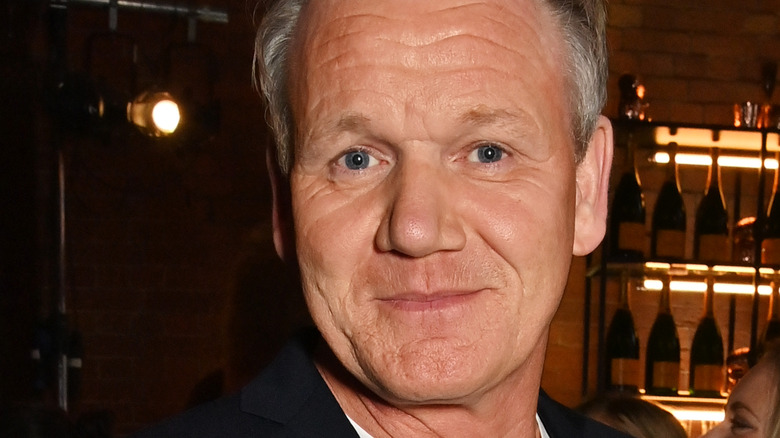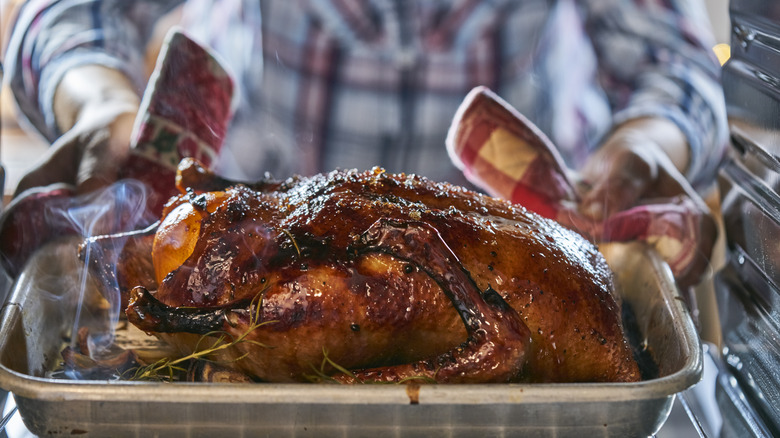The Types Of Turkey Gordon Ramsay Turns To For A Succulent Roast
Although Thanksgiving is an American holiday not celebrated across the pond, you'd be hard-pressed to find someone who can cook a better turkey than chef Gordon Ramsay. The "Hell's Kitchen" and "Kitchen Nightmares" icon knows how to roast a mean turkey, and it all comes down to the kind of turkey that the chef chooses. In particular, Ramsay is a fan of centering his dinner table around a Norfolk Black or Bronze turkey.
For those who don't know much about turkey besides a Butterball, then consider this education on the fowl. Both Norfolk Black and Bronze turkeys are a particular breed of turkey in Great Britain. They're both considered free-range turkeys, if you're trying to find an equivalent in the United States. Free-range turkeys are raised with room to roam, making them more of an ethical choice. Many consider free-range turkeys to taste better as well. Mary's Turkeys is a popular free-range brand in America.
That being said, there are some differences between Norfolk Bronze and Black. Generally, Norfolk Black turkeys resemble pheasants and are considered to be smaller, firmer birds. In comparison, Bronze are considered to be tastier and juicer of the two types. It's also worth noting the size of Ramsay's preferred turkey.
Are smaller turkeys better?
Generally, Gordon Ramsay prefers his turkeys on the smaller side. While the average turkey sold weighs between 8 to 24 pounds, Ramsay believes the sweet spot to be somewhere around 12 pounds (5–5.5kg). So it begs the question if a smaller turkey is better than a larger one. Although it may go against that image of that giant bird on the table at dinner time, you may want to consider following Ramsay's lead on this one.
Generally, smaller birds are more tender than larger birds. For one, smaller birds tend to be hens, which are more tender than toms. Likewise, cooking plays a big role as well. Generally, smaller turkeys cook more evenly than their larger siblings. It makes a certain amount of sense. Larger birds typically increase the amount of time required in the oven due to a larger mass. Generally, white meat cooks faster than dark meat as well, so the longer the time spent in the oven, the greater the risk that those wings and breasts may be a bit overdone. For that reason, you may want to consider buying two smaller birds rather than one larger one. Ramsay also has a couple of tricks for making those turkeys flavorful.
Gordon Ramsay tricks for a flavorful feast
You want to make sure your turkey is juicy and tender and doesn't end up like a scene from "National Lampoon's Christmas Vacation" (extremely overbaked, for those who've never seen the holiday classic). However, it wouldn't be the holidays without a mishap, and turkeys never seem to behave as well as chickens. It's because turkeys are leaner meat. They have a smaller amount of dark meat compared to chicken, due to their uneven breast and wings to thighs and legs ratio. Fortunately, you don't have to settle for a dry turkey, and you don't even have to break out that baster.
Gordon Ramsay likes to create a nice butter marinade for his turkey. One of the first things he does before putting the turkey in the oven is make a butter and garlic mixture. Feel free to throw in whatever seasonings you prefer. The trick here is to layer the butter under the skin of the turkey, giving a nice protective layer to the meat. Since butter is essentially animal fat, you're adding a bit of moisture and grease that is naturally missing from the bird. The other trick is to take the bird out of the oven to baste it with melted butter as it cooks.


